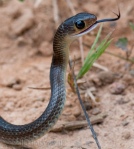Ptyas korros

English name: Indo-Chinese Rat Snake
Scientific name: Ptyas korros
Thai name: Ngu Sing Ban, Ngu Hao Ta-lan
Description: To 256cm long. One of the largest snakes in Bangkok other than the pythons. Brown or olive above, yellowish on the chin and underbelly. Eyes are notably large. Young juveniles have white bands or spots on body.
Similar Species: Oriental Rat Snake has dark bands on the last third of its body.
Monacled Cobra has smaller eyes, loose skin around the neck, and a characteristic marking on the back of the neck/head that expands when displaying.
All other large brown snakes in Bangkok have characteristic stripes, bands, or other markings on the head or body.
Habitat: Prefers open habitat such as grassland, shrubland, open woodland, agriculture, and the open banks of water bodies. Can be found in trees (especially when resting) and is a good swimmer.
Place in the ecosystem: Helps control rodent populations by eating rats and mice, but also feeds on frogs, lizards, smaller snakes, and birds. Their juveniles are eaten by larger snakes, monitors, and birds of prey.
Danger to humans: This large snake is aggressive and can inflict a nasty bite, but it is non-venomous and cannot cause any serious injury.
Conservation status and threats: The Indo-Chinese Rat Snake has no known conservation issues in Thailand, but is hunted for its meat and gallbladder and is listed as endangered in China.
Interesting facts: When captured this snake will thrash its body about violently, which together with its large size makes it difficult to handle.
References:
Snakes of Taiwan: Ptyas korros
University of Hong Kong: Ptyas korros
A Photographic Guide to Snakes and Other Reptiles of Peninsular Malaysia, Singapore and Thailand
A Field Guide to the Reptiles of South-East Asia









Hi,
I often find snakes in my garden at Banglamung.
This morning I found two big brown/grey snakes coupling and took two pictures to try and identify them.
Do you have an email address where I can send the pictures for you to tell me what they are. I believe they are rat snakes but my maid say they are king cobras. I don’t believe.
Please let me know
I have sent a response to the email in your comment submission form.